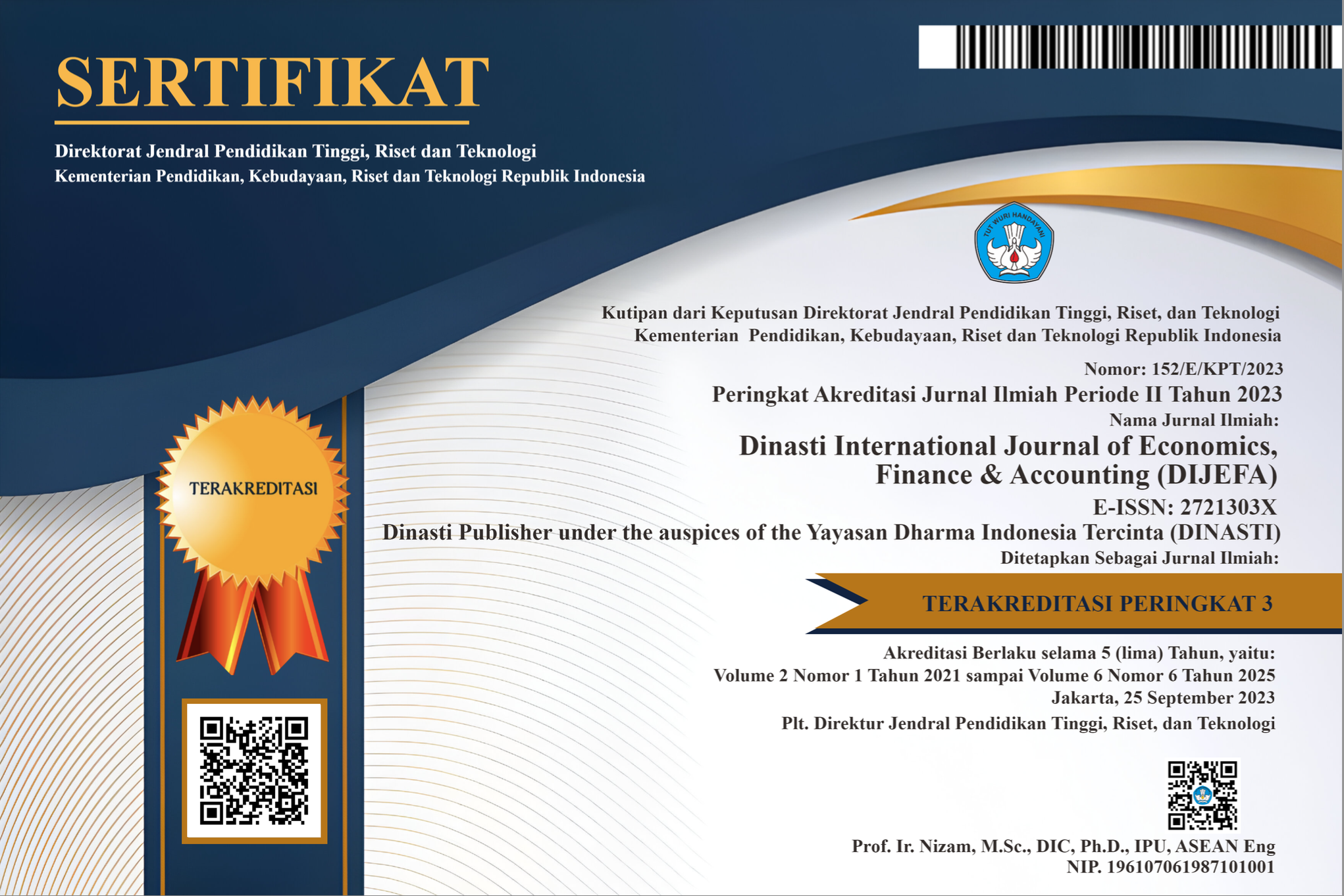The Consequences of Interest Rate Risk and Credit Risk on Profitability (Empirical Study on Banking Companies Listed on the Indonesia Stock Exchange)
DOI:
https://doi.org/10.38035/dijefa.v5i4.3169Keywords:
Interest Rate Risk, Credit Risk, and ProfitabilityAbstract
This research aims to test and analyze the influence of interest rate risk and credit risk on profitability (empirical study of banking companies listed on the Indonesian Stock Exchange). The population in this study was 43 companies obtained using a purposive sampling method on Banking companies during the 2020-2022 period and based on predetermined criteria, a sample of 34 manufacturing companies listed on the Indonesia Stock Exchange was obtained. The total sample data for the 2020-2022 period is 102 samples. The analysis method used is multiple linear analysis with the help of SPSS software. The research results show that interest rate risk have a positive and significant effect on the profitability of banking companies listed on the Indonesian Stock Exchange in 2020-2022. And credit risk has a negative and significant impact on profitability in banking companies listed on the Indonesian Stock Exchange in 2020-2022.
References
Adhim, Chairul. (2019). The Effect of Credit Risk, Liquidity Risk, and Management Efficiency on Profitability: A Study on Banks Listed on the Indonesia Stock Exchange. CENDEKIA, Vol. 13 No. 2. E-ISSN: 2407-8557
Aditya Dimas, Riyadi. (2014). Understanding Financial Statements (Accessed on February 14, 2024) [www.Google.com]
Aji, I. K., & Manda, G. S. (2021). The Effect of Credit Risk and Liquidity Risk on Profitability in State-Owned Banks. *JAD: Jurnal Riset Akuntansi & Keuangan Dewantara*, 4(1), 36-45
Alexander, C. A. (2021). The Impact of Credit Risk, Liquidity Risk, and Market Risk on Profitability (Doctoral dissertation, UNIVERSITAS BAKRIE).
Anggreni, M., & Suardhika, I. M. S. (2014). The Influence of Third Party Funds, Capital Adequacy, Credit Risk, and Credit Interest Rates on the Profitability of State-Owned Banks for the Period 2010-2012. *E-Jurnal Akuntansi*, 9(1), 27-38.
Anindiansyah, G., Sudiyatno, B., Puspitasari, E., & Susilowati, Y. (2020). The Influence of CAR, NPL, BOPO, and LDR on ROA with NIM as an Intervening Variable (Study on Publicly Listed Banks in the Indonesia Stock Exchange for the Period 2015-2018).
Ariwidanta, K. T. (2016). The Impact of Credit Risk on Profitability with Capital Adequacy as a Mediating Variable. *E-Jurnal Manajemen Unud*, Vol. 5, No. 4: 2311-2340 ISSN: 2311-2340.
Aulia, I., & Antyo, P. (2018). Analysis of the Impact of Capital, Credit Risk, and Liquidity Risk on Profitability at PT Bank. *Jurnal Ilmu Manajemen & Ekonomika*, Vol. 10 (2), 44-50.
Bank Indonesia, 2022. *Indonesian Economic Report*. [http://www.bi.go.id]
Bank Indonesia. 1998. Law No. 10 of 1998 on Amendments to Law No. 7 of 1992, Jakarta.
Bank Indonesia. Regulation of Bank Indonesia 13/01/PBI/2011. *Bank General Health As-sessment*. www.bi.go.id.
Bank Indonesia. Regulation of Bank Indonesia No. 17/11/PBI/2015 on Minimum Reserve Requirements for General Banks in Rupiah and Foreign Currency for Conventional General Banks. www.bi.go.id.
Indonesia Stock Exchange, Annual Financial Reports 2020, 2021, and 2022. (accessed at http://www.idx.co.id)
Chanifah, S. (2020). The Influence of Capital Adequacy, Liquidity, and Credit Risk on Prof-itability of Conventional Banking Companies on the Stock Exchange.
Dadang Prasetyo Jatmiko. (2017). *Introduction to Financial Management*. First Edition. Diandra Kreatif. Yogyakarta.
Dendawijaya, Lukman. (2015). *Bank Management*, Second Edition, Jakarta: Ghalia Indo-nesia.
Dewi, E. T., & Srihandoko, W. (2018). The Impact of Credit Risk and Liquidity Risk on Bank Profitability: A Case Study of State-Owned Banks for the Period 2008-2017. *Jurnal Ilmiah Manajemen Kesatuan*, Vol. 6 No. 3, pp. 131-138 STIE Kesatuan ISSN 2337-7860.
Erni, Y. N., & Sri, A. (2019). The Impact of SBI Interest Rate Policy on Banking Profitability (Case Study of Conventional and Islamic BPRs in Batam City). *Jurnal Akuntansi Barelang*, Vol. 4, No. 1.
Fahmi, Irham. (2014). *Corporate and Capital Market Financial Management*. Jakarta: Mitra Wacana Media.
Fitri, A. D. (2016). The Impact of Market Risk, Credit Risk, and Operational Risk on the Fi-nancial Performance of Banks (Empirical Study on Banking Companies Listed on IDX for the Period 2010-2015). *Jurnal Akuntansi*, 4(1).
Gendro Wiyono and Hadri Kusuma. (2017). *Advanced Financial Management: Based on Corporate Value Creation*. UPP STIM YKPN, Yogyakarta.
Ghozali. (2016). *Application of Multivariate Analysis with IBM SPSS Program*. Semarang: Diponegoro University Publishing Agency.
Handayani, W. (2017). The Impact of Credit Risk, Liquidity Risk, and Interest Rate Risk on ROA. *SIKAP: Information Systems, Finance, Auditing and Taxation*, Vol. 1 (No.2), pp. 157-163 P-ISSN: 2541-1691.
Indonesian Institute of Accountants (IAI). (2014). *Financial Accounting Standards*. Jakarta: Salemba Empat.
Indonesian Bankers Association. (2016). *Risk-Based Bank Health Management*. Jakarta: PT Gramedia Pustaka Utama.
Kasmir. (2014). *Fundamentals of Banking*. Revised Edition, Twelfth Printing, PT. Raja-Grafindo Persada, Jakarta.
Khotijah, N. Z., Suharti, T., & Yudhawati, D. (2020). The Influence of Interest Rates and Inflation on Profitability. *Manager: Journal of Management Sciences*, 3(1), 40-47.
Musthafa. (2017). *Financial Management*. Yogyakarta: CV. Andi Offset.
Mose, A. C., Tommy, P., & Untu, V. (2018). The Impact of Market Risk and Credit Risk on Profitability in State-Owned General Banks Listed on IDX for the Period 2012-2016.
Natalia, P. (2015). Analysis of the Impact of Credit Risk, Market Risk, Operational Efficiency, Capital, and Liquidity on Banking Financial Performance (Case Study on State-Owned Banks Listed on IDX for the Period 2009-2012). *Journal of Economics, Management and Banking*, Vol. 1 No. 2 August 2015: 62-73 ISSN 2460-8114.
Financial Services Authority (OJK). Regulation of the Financial Services Authority No. 18/POJK.03/2016 on the Annual Report of Issuers or Public Banking Companies.
Pandia, Frianto. (2016). *Fund and Bank Health Management*. Jakarta: Rineka Cipta.
Pinasti, W. F., & Mustikawati, R. I. (2018). The Impact of CAR, BOPO, NPL, NIM, and LDR on Bank Profitability for the Period 2011-2015. *Nominal: Barometer of Accounting and Management Research*, 7(1), 126-142.
Prastowo, P. R., Mardani, R. M., & Wahono, B. (2018). Analysis of the Impact of Inflation, Interest Rates, and Exchange Rates on Banking Profitability. *E-JRM: Electronic Journal of Management Research*, 7(16).
Rahmi, C. L. (2014). The Impact of Credit Risk, Liquidity Risk, and Interest Rate Risk on Profitability (Empirical Study on Banking Companies Listed on the Indonesia Stock Exchange). *Jurnal Akuntansi*, Vol. 2, No. 2.
Robby, A. M., & Yuliastuti, R. (2020). The Impact of Liquidity, Credit Risk, and Capital Adequacy Ratio on Profitability. *Journal of Accounting Research and Practice*, Vol. 9, No. 4.
Sante, Z. V., Murni, S., & Tulung, J. E. (2021). The Impact of Credit Risk, Liquidity Risk, and Operational Risk on Profitability of Companies in LQ45, Book III, and Book IV for the Period 2017-2019. *Jurnal EMBA: Journal of Economic Research, Management, Business and Accounting*, 9(3), 1451-1462.
Shama, N., Asia, L., & Fozia, P. (2018). Interest Rate Changes and Their Impact on the Prof-itability of General Banks in Pakistan. *International Journal of Academic Research in Business and Social Sciences*, Vol. 8, No. 12.
Sugiyono. (2018). *Quantitative Research Methods*. Bandung: Alfabeta.
Sukma, N., Saerang, I. S., & Tulung, J. E. (2019). The Impact of Third Party Funds, Credit Risk, Market Risk, and Operational Risk on Profitability in Category II Banks for the Period 2014-2017. *Jurnal EMBA*, Vol. 7 No. 3, pp. 2751-2760 ISSN 2303-1174.
Downloads
Published
How to Cite
Issue
Section
License
Copyright (c) 2024 Chaerunnisa Rumianti, Yoshia Chery T, Angelitha Natalia Landa, Carlos Fernandes, Muhammad Irfandi Anas, Olivia Nura Linthin

This work is licensed under a Creative Commons Attribution 4.0 International License.
Authors who publish their manuscripts in this journal agree to the following conditions:
- The copyright on each article belongs to the author(s).
- The author acknowledges that the Dinasti International Journal of Economics, Finance & Accounting (DIJEFA) has the right to be the first to publish with a Creative Commons Attribution 4.0 International license (Attribution 4.0 International (CC BY 4.0).
- Authors can submit articles separately, arrange for the non-exclusive distribution of manuscripts that have been published in this journal into other versions (e.g., sent to the author's institutional repository, publication into books, etc.), by acknowledging that the manuscript has been published for the first time in the Dinasti International Journal of Economics, Finance & Accounting (DIJEFA).


























































